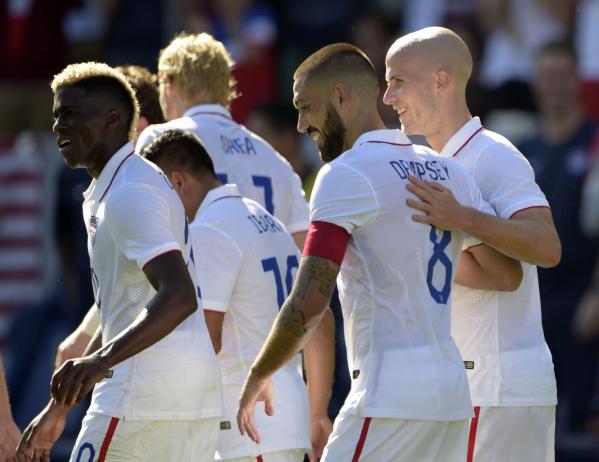By FRANCO PANIZO
After five months without a victory, and some recent horrendous defensive displays, the U.S. Men’s National Team restored some faith and gave fans some reasons for optimism after Sunday’s 2-0 win vs. Panama.
From U.S. head coach Jurgen Klinsmann’s shift back to a more familiar formation to the strong performances of the likes of Michael Bradley and Gyasi Zardes, the Americans learned quite a bit about themselves before dispersing until they reconvene for their next camp in March.
As you could expect, there were plenty of positives for Klinsmann and his side to take from the shutout victory. But it was not all rosy either, as there are questions that still remain with regards to tactics and personnel.
Here are SBI’s biggest takeaways following the U.S. team’s 2-0 win against Panama:
BRADLEY LOOKED LIKE BRADLEY OF OLD
There has been much discussion in recent months as to where Bradley is best-suited to play for the U.S., but Sunday’s game gave more ammunition to those who think he does not need to serve high up the field to be very effective.
With Klinsmann opting to go back to a 4-2-3-1, Bradley was used in his more customary box-to-box role against Panama. Bradley was not perfect coming out of the gates, but was active early on and settled into the match. After a mixed first 20 minutes, Bradley found the game. He dropped deep at times to find the ball and help build up attacks, and moved to more advanced positions in other instances to try and break down the Panamanian defense.
It should come as no surprise then that this was one of Bradley’s best performances in recent memory, and it was fitting that it was he who scored the game’s winner on an incredible and rare Olimpico.
ZARDES SHOWING PLENTY EARLY ON
Forget the perfectly weighted-ball that set up Clint Dempsey’s insurance goal for a second. Zardes still did enough encouraging things during the rest of his 89 minutes on the field to garner more looks from Klinsmann. Deployed on the right side of the midfield in his first start for the U.S., Zardes showed no signs of nervousness and did solid work on both sides of the ball. He covered passing lanes, intercepted passes and showed the poise of a veteran when in possession of the ball.
On one eye-opening play in the first half, Jozy Altidore swung a cross from the left in Zardes’ direction. Rather than bringing it down, playing it safe and possibly killing the attack’s momentum, Zardes astutely chested the ball in one smooth motion into the path of Bradley for a shot on goal from the top of the penalty area. Bradley did not get enough on his shot to test Jaime Penedo, but the veteran midfielder made sure to give a big high-five to Zardes for the heads-up play.
It’s early, but the returns so far on Zardes are promising.
WHAT’S NEXT FOR YEDLIN?
DeAndre Yedlin’s day ended unceremoniously, with an injury forcing him out of a game in which he was the weakest link across the U.S. back line. The speedy youngster reverted to his natural right back spot in this one, but struggled in the first half with both his defending and distribution before the U.S. took control of the game and eased off some pressure from the defense.
While the injury Yedlin sustained is not deemed to be serious, what role he has with the U.S. over the next few months is unclear. His defensive skills still need a lot of polish and he needs to work off some offseason rust, but he will not be able to work on any of that in competitive matches until he breaks into Tottenham’s game-day roster. That seems like a tall task considering Spurs are mere points away from a coveted UEFA Champions League spot, but one he will have to overcome in order to avoid falling a step behind his in-form teammates.
IBARRA UNABLE TO MAKE AN IMPACT
Miguel Ibarra has been a regular among Klinsmann’s selections ever since earning his first call-up last October, but the Minnesota United winger will need to do more than he did Sunday in order for that to keep being the case.
Ibarra received his first start in just his second appearance for the U.S., but his showing against Panama left a lot to be desired despite Klinsmann’s positive postgame review. Ibarra, to his credit, showed a couple of flashes early on – including cleverly dribbling past a defender near midfield – but did not do much else. The few crosses he had fizzled, and he was not able to provide much of a threat from the left flank.
At 24, Ibarra still has plenty of promise. He just might not be ready for the international scene as of now.
DEFENSE MORE COMFORTABLE IN FOUR-MAN BACK LINE
No, Panama’s attack isn’t quite as good as Chile’s, but the U.S. defense looked more at ease playing with four men at the back than three.
That should not come as much of a surprise given that the 3-5-2 look is an experiment that still needs plenty of fine-tuning, but the structure of a four-man back line gave an added benefit to the U.S. that was clear to see.
With the American defenders being a little more familiar with their roles, what areas to mark and who would cover for them on any given play, the defense pitched its first cleansheet since the U.S. last won a game in September. Yedlin had his troubles on the right, but left back Brek Shea built on his defensive showing with Chile while the central tandem of Jermaine Jones and Matt Besler was solid.
A three-man back line is still likely in the cards, and Klinsmann will now need to think long and hard about what is his best defensive approach for March’s pair of European friendlies.

